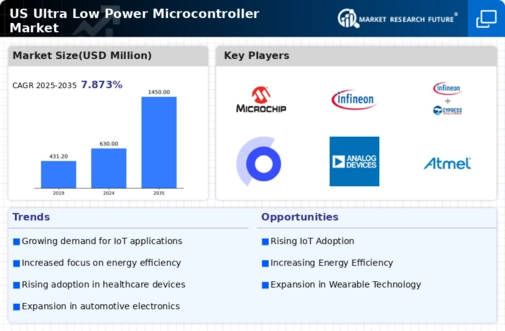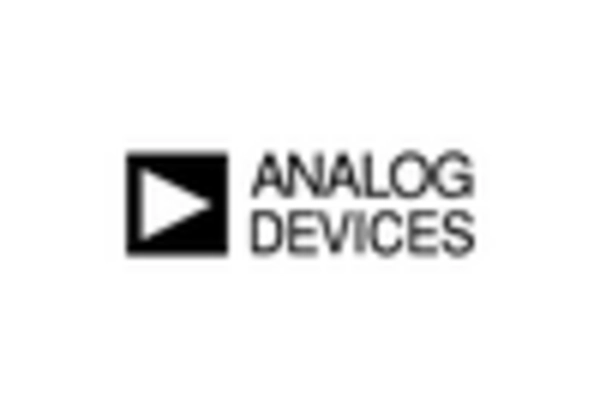Expansion of Smart Home Devices
The proliferation of smart home devices significantly influences the ultra low-power-microcontroller market. As households increasingly adopt smart technologies for automation and energy management, the demand for microcontrollers that can operate efficiently with low power consumption rises. The smart home market is expected to surpass $150 billion by 2025, creating a substantial opportunity for ultra low-power microcontrollers. These devices require microcontrollers that can manage various functions, such as lighting, security, and climate control, while maintaining energy efficiency. Consequently, manufacturers are focusing on developing microcontrollers that not only meet performance standards but also align with the growing consumer preference for sustainable and energy-efficient solutions, thereby driving the ultra low-power-microcontroller market.
Advancements in Battery Technology
Innovations in battery technology are poised to impact the ultra low-power-microcontroller market positively. As battery life becomes a critical factor for consumer electronics, the demand for microcontrollers that can optimize power usage is likely to increase. Recent advancements in battery technologies, such as lithium-sulfur and solid-state batteries, promise longer life cycles and faster charging times. This evolution necessitates the integration of ultra low-power microcontrollers that can effectively manage power consumption and extend device longevity. The synergy between improved battery technology and ultra low-power microcontrollers could lead to enhanced performance in various applications, including IoT devices and portable electronics, thereby fostering growth in the ultra low-power-microcontroller market.
Growing Adoption of Wearable Technology
The increasing popularity of wearable technology is a key driver for the ultra low-power-microcontroller market. As consumers seek devices that monitor health metrics, fitness levels, and other personal data, manufacturers are compelled to integrate ultra low-power microcontrollers to enhance battery life and performance. The wearable technology market is projected to reach $60 billion by 2025, indicating a robust demand for energy-efficient solutions. This trend necessitates the development of microcontrollers that can operate effectively with minimal power consumption, thereby propelling growth in the ultra low-power-microcontroller market. Furthermore, the need for compact and lightweight designs in wearables further emphasizes the importance of ultra low-power microcontrollers, as they allow for smaller form factors without compromising functionality.
Rising Focus on Environmental Sustainability
The growing emphasis on environmental sustainability is a significant driver for the ultra low-power-microcontroller market. As industries and consumers alike become more conscious of their carbon footprints, there is a heightened demand for energy-efficient solutions. Ultra low-power microcontrollers play a crucial role in reducing energy consumption across various applications, from industrial automation to consumer electronics. Companies are increasingly adopting these microcontrollers to comply with environmental regulations and meet consumer expectations for sustainable products. The trend towards sustainability is expected to influence purchasing decisions, thereby propelling the ultra low-power-microcontroller market as manufacturers strive to create eco-friendly solutions that align with this global movement.
Increased Investment in Smart Grid Technologies
The surge in investment in smart grid technologies is a notable driver for the ultra low-power-microcontroller market. As utility companies seek to modernize infrastructure and improve energy efficiency, the integration of ultra low-power microcontrollers becomes essential. These microcontrollers facilitate real-time monitoring and control of energy distribution, which is critical for optimizing grid performance. The smart grid market is projected to grow significantly, with investments expected to reach $100 billion by 2025. This growth creates a demand for microcontrollers that can operate efficiently in various environmental conditions while consuming minimal power. Consequently, the ultra low-power-microcontroller market stands to benefit from the increasing focus on smart grid solutions, as they are integral to the successful implementation of these technologies.
















Leave a Comment